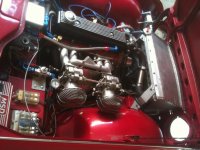SMGoose
Senior Member
Offline
New member here, one with a problem on a recently purchased TR4. I was hoping this forum could help me.
I'll try to be brief. On a cold start, it takes a bit to turn over, then rough idles for a while until it warms up. Giving it gas causes backfire and sputtering from the carburetors. Even once the idle levels out, it takes a good while until you can accelerate without stuttering.
I took it to a local shop that works on old British cars to have them set the gaps, check the timing, and tune the carbs. It didn't really help the next time I started it up. So I checked the plugs, which were fouled (dry, carbon), changed them out to no avail.
I thought maybe the fuel delivery was a problem. In checking that out, I found a gas leak from the tank outlet (right above the exhaust, no less). Ended up putting in a new gas tank and replacing the old SU electric fuel pump (I have no idea why it was in there as it's not original to the TR4) with a Facet solid-state while I was messing with it. None of these things have helped the misfiring problem. In fact, the new plugs have fouled after maybe 10 miles of driving.
I've tried to do some electrical checks to the best of my ability with a digital multimeter. Tomorrow I plan to pump the fuel into a jug to make sure it's not the fuel system. Any other suggestions would be MUCH appreciated!
Other notes that might affect the situation: In changing the fuel pump, I converted from positive ground to negative ground. I didn't notice before the conversion, but now the ammeter reads 0 once the idle is stable, but accelerating makes it jump to +30. Also, another strange thing about the car is that the coil is a Lucas CL 73 with an external resistor. This is also not an original setup for the car, correct? What type of spark plugs do you fellas use? I bought NGK BPR6HS. The previous ones were a "4" I believe. So much for brevity...
I'll try to be brief. On a cold start, it takes a bit to turn over, then rough idles for a while until it warms up. Giving it gas causes backfire and sputtering from the carburetors. Even once the idle levels out, it takes a good while until you can accelerate without stuttering.
I took it to a local shop that works on old British cars to have them set the gaps, check the timing, and tune the carbs. It didn't really help the next time I started it up. So I checked the plugs, which were fouled (dry, carbon), changed them out to no avail.
I thought maybe the fuel delivery was a problem. In checking that out, I found a gas leak from the tank outlet (right above the exhaust, no less). Ended up putting in a new gas tank and replacing the old SU electric fuel pump (I have no idea why it was in there as it's not original to the TR4) with a Facet solid-state while I was messing with it. None of these things have helped the misfiring problem. In fact, the new plugs have fouled after maybe 10 miles of driving.
I've tried to do some electrical checks to the best of my ability with a digital multimeter. Tomorrow I plan to pump the fuel into a jug to make sure it's not the fuel system. Any other suggestions would be MUCH appreciated!
Other notes that might affect the situation: In changing the fuel pump, I converted from positive ground to negative ground. I didn't notice before the conversion, but now the ammeter reads 0 once the idle is stable, but accelerating makes it jump to +30. Also, another strange thing about the car is that the coil is a Lucas CL 73 with an external resistor. This is also not an original setup for the car, correct? What type of spark plugs do you fellas use? I bought NGK BPR6HS. The previous ones were a "4" I believe. So much for brevity...

 Hi Guest!
Hi Guest!

 smilie in place of the real @
smilie in place of the real @
 Pretty Please - add it to our Events forum(s) and add to the calendar! >>
Pretty Please - add it to our Events forum(s) and add to the calendar! >> 


